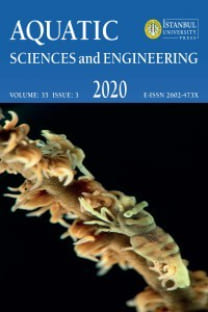Optimization of Culture Conditions for Total Carotenoid Amount Using Response Surface Methodology in Green Microalgae / Ankistrodesmus convolutus
Chlorella vulgaris, Ankistrodesmus convolutus, Dunaliella salina Tetraselmis striata, Carotenoid, Optimization, Photobioreactor,
___
- Ambati, R. R., Gogisetty, D., Aswathanarayana, R. G., Ravi, S., Bikkina, P. N., Bo, L., & Yuepeng, S. (2019). Industrial potential of carotenoid pigments from microalgae: Current trends and future prospects. Critical reviews in food science and nutrition, 59(12), 1880-1902. [CrossRef] google scholar
- Bajwa, K., Bishnoi, N. R., Kirrolia, A., Gupta, S., & Selvan, S. T. (2019). Response surface methodology as a statistical tool for optimization of physio-biochemical cellular components of microalgae Chlorella pyrenoidosa for biodiesel production. Applied Water Science, 9(5), 128. [CrossRef] google scholar
- Cezare-Gomes, E. A., del Carmen Mejia-da-Silva, L., Perez-Mora, L. S., Matsudo, M. C., Ferreira-Camargo, L. S., Singh, A. K., & de Carvalho, J. C. M. (2019). Potential of Microalgae Carotenoids for Industrial Application. Applied biochemistry and biotechnology, 188(3), 602634. [CrossRef] google scholar
- Chen, T., & Wang, Y. (2013). Optimized astaxanthin production in Chlorella zofingiensis under dark condition by response surface methodology. Food Science and Biotechnology, 22(5), 1-8. [CrossRef] google scholar
- Coelho, D. D. F., Tundisi, L. L., Cerqueira, K. S., Rodrigues, J. R. D. S., Mazzola, P. G., Tambourgi, E. B., & Souza, R. R. D. (2019). Microalgae: Cultivation Aspects and Bioactive Compounds. Brazilian Archives of Biology and Technology, 62. [CrossRef] google scholar
- Demirel, Z., Imamoglu, E., Deniz, İ., & Dalay, M. C. Optimization of Cryopreservation Process Using Response Surface Methodology for Chlorella saccharophila and Chlorella zofingiensis. Celal Bayar Üniversitesi Fen Bilimleri Dergisi, 14(4), 405-412. [CrossRef] google scholar
- Demirel, Z., Yilmaz, F. F., Ozdemir, G., & Dalay, M. C. (2018). Influence of Media and Temperature on the Growth and the Biological Activities of Desmodesmus protuberans (FE Fritsch & MF Rich) E. Hegewald. Turkish Journal of Fisheries and Aquatic Sciences, 18(10), 1195-1203. [CrossRef] google scholar
- Di Lena, G., Casini, I., Lucarini, M., & Lombardi-Boccia, G. (2019). Carotenoid profiling of five microalgae species from large-scale production. Food research international, 120, 810-818. [CrossRef] google scholar
- Erdoğan, A., Çağır, A., Dalay, M. C., & Eroğlu, A. E. (2015). Composition of carotenoids in Scenedesmus protuberans: Application of chromatographic and spectroscopic methods. Food analytical methods, 8(8), 1970-1978. [CrossRef] google scholar
- Faraloni, C., & Torzillo, G. (2017). Synthesis of antioxidant carotenoids in microalgae in response to physiological stress. Carotenoids. IntechOpen, 143-157. [CrossRef] google scholar
- Gonçalves, C. F., Menegol, T., & Rech, R. (2019). Biochemical composition of green microalgae Pseudoneochloris marina grown under different temperature and light conditions. Biocatalysis and agricultural biotechnology, 18, 101032. [CrossRef] google scholar
- Keskin Gündoğdu, T., Deniz, I., Çalışkan, G., Şahin, E. S., & Azbar, N. (2016). Experimental design methods for bioengineering applications. Critical reviews in biotechnology, 36(2), 368-388. [CrossRef] google scholar
- Novoveskâ, L., Ross, M. E., Stanley, M. S., Pradelles, R., Wasiolek, V., & Sassi, J. F. (2019). Microalgal carotenoids: A review of production, current markets, regulations, and future direction. Marine drugs, 17(11), 640. [CrossRef] google scholar
- Saha, S. K., Ermis, H., & Murray, P. (2020). Marine microalgae for potential lutein production. Applied Sciences, 10(18), 6457. [CrossRef] google scholar
- Senge, M., & Senger, H. (1990). Response of the photosynthetic apparatus during adaptation of Chlorella and Ankistrodesmus to irradiance changes. Journal of plant physiology, 136(6), 675-679. [CrossRef] google scholar
- Singh, D. P., Khattar, J. S., Rajput, A., Chaudhary, R., & Singh, R. (2019). High production of carotenoids by the green microalga Asterarcys quadricellulare PUMCC 5.1. 1 under optimized culture conditions. PloS one, 14(9), e0221930. [CrossRef] google scholar
- Sun, X. M., Ren, L. J., Zhao, Q. Y., Ji, X. J., & Huang, H. (2018). Microalgae for the production of lipid and carotenoids: a review with focus on stress regulation and adaptation. Biotechnology for biofuels, 11(1), 272. [CrossRef] google scholar
- Şenaras, A. E. (2019). Parameter optimization using the surface response technique in automated guided vehicles. In Sustainable Engineering Products and Manufacturing Technologies (pp. 187-197). Academic Press. [CrossRef] google scholar
- Şahin, S., Nasir, N. T. B. M., Erken, İ., Çakmak, Z. E., & Çakmak, T. (2019). Antioxidant composite films with chitosan and carotenoid extract from Chlorella vulgaris: optimization of ultrasonic-assisted extraction of carotenoids and surface characterization of chitosan films. Materials Research Express, 6(9), 095404. [CrossRef] google scholar
- Takaichi, S. (2011). Carotenoids in algae: distributions, biosyntheses and functions. Marine drugs, 9(6), 1101-1118. [CrossRef] google scholar
- Wang, L. J., Fan, Y., Parsons, R., Hu, G. R., Zhang, P. Y., & Li, F. L. (2018). A rapid method for the determination of fucoxanthin in diatom. Marine drugs, 16(1), 33. [CrossRef] google scholar
- Wang, S., Cao, M., Wang, B., Deng, R., Gao, Y., & Liu, P. (2019). Optimization of growth requirements and scale-up cultivation of freshwater algae Desmodesmus armatus using response surface methodology. Aquaculture Research. [CrossRef] google scholar
- Wellburn, A. R. (1994). The spectral determination of chlorophylls a and b, as well as total carotenoids, using various solvents with spectrophotometers of different resolution. Journal of plant physiology, 144(3), 307-313. [CrossRef] google scholar
- Yayın Aralığı: Yılda 4 Sayı
- Başlangıç: 1987
- Yayıncı: İstanbul Üniversitesi
Seher DİRİCAN, Aydın KALELİ, Elif YILMAZ, Ali ÖZER, Hayri DAYIOĞLU
Sanzib Kumar BARMAN, Helena KHATOON, Mohammad Redwanur RAHMAN, Sabuj Kanti MAZUMDER, Shanur HASAN
Sabuj Kanti MAZUMDER, Mohammad Abdus SALAM, Md. Arifur Rahman KHAN, Sarker Mohammed IBRAHIM KHALIL, Md. Tawheed HASAN
Melek İŞİNİBİLİR, Esin YÜKSEL, Ezgi TÜRKERİ, Onur DOĞAN, Firdes Saadet KARAKULAK, Uğur UZER, Cem DALYAN, Giulia FURFARO, Stefano PİRAİNO
Neslihan ŞENER, Zeliha DEMİREL, Esra İMAMOĞLU, Meltem DALAY
